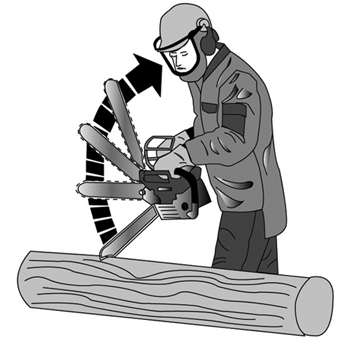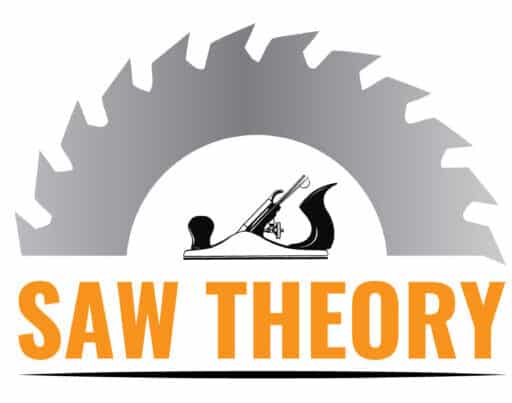Chainsaw kickback is a dangerous and potentially fatal event for operators. To prevent chainsaw kickback, make sure the chainsaw is well-maintained and in good working order. Also, check that the chain tension is correct before use – too tight or too loose can cause kickback.
When cutting, always hold the chainsaw firmly with both hands and keep them on either side of its rear handle to ensure control over it while using it. Keep your left thumb tucked away from the guide bar nose as this will help reduce injuries if there’s an unexpected kickback. Avoid cutting at full throttle, as higher revs increase your risk of experiencing a kickback episode.
Additionally, never cut above shoulder level or reach behind you when operating a chainsaw; these are two key factors that contribute to accidents involving kickbacks.
- Check Your Chainsaw: Prior to using your chainsaw, make sure it is in proper working order and that all safety features are functioning properly. Inspect the chain for any signs of wear or damage, ensure it is correctly fitted and has adequate tension, and check that the other components of the chainsaw are in good condition.
- Always Wear Safety Gear: As with any power tool, operating a chainsaw requires protective gear such as eye protection, hearing protection, and heavy work gloves to reduce potential injuries from kickback or contact with moving parts of the saw.
- Use Low Kickback Chain: When purchasing a replacement chain for your chainsaw, make sure you get one labeled as “low-kickback” which will reduce the risk of kickback occurring when using your saw due to its design features which limit how much force can be generated during cutting operations.
- Maintain Proper Cutting Techniques: Always use two hands when operating a chainsaw – never operate it single-handedly! Keep both hands on either side of the handlebar at all times while keeping the body away from the front end of the bar; keep the arm extended out straight away from the direction you are cutting; avoid cutting too deeply into the material being cut; keep thumb back behind rear handle grip so fingers aren’t caught between bar and tree if kickback occurs; slow down near final cutout stage where wood fibers become separated at end piece (this reduces likelihood kickbacks)

Credit: thepowersite.co.uk
How Do You Avoid a Kickback from a Chainsaw?
When operating a chainsaw, it is essential to take the proper safety measures in order to avoid kickbacks. First and foremost, you should always wear personal protective equipment (PPE) such as gloves, chaps, eye protection, and hearing protection when using this type of power tool. Additionally, make sure that your saw chain is properly sharpened and tensioned at all times; a dull or loose chain can lead to dangerous kickbacks.
You should also maintain a firm grip on the handle with both hands while cutting; never remove either hand from the handles during operation as this increases your risk of kickback. Finally, be sure to follow any manufacturer’s safety instructions for the use of the chainsaw including keeping your arms close together while cutting and avoiding contact with other objects such as trees or branches while using the saw. Following these steps will help ensure the safe operation of your chainsaw and reduce the chances of kickback-related injuries.
What Causes a Chainsaw to Kickback?
Chainsaw kickback occurs when the tip of the chainsaw blade gets caught on an object while cutting and is forced back toward the operator. It can be caused by a variety of factors, including incorrect angling of the saw, dull chain blades, clogged or dirty chains, improper tensioning of the chain drive system, and/or inadequate maintenance.
To minimize kickback risk, it’s important to ensure that your chain is in good condition with sharpened blades and properly adjusted tension. Additionally, you should always maintain proper form when operating a chainsaw; this includes keeping a firm grip on both handles at all times and ensuring that your body remains far enough away from the front bar so as not to get kicked back if kickback does occur.
What is a Chainsaw Kickback Guard?
A chainsaw kickback guard is an important safety feature designed to reduce the chances of a dangerous kickback when using a chainsaw. This safety device is typically composed of two parts – the bar tip and the nose sprocket cover – which are both connected to the bar and chain assembly at either end.
The bar tip acts as a shield that can prevent contact between your hand and any moving chain components, while the nose sprocket cover helps protect you from potential contact with spinning teeth in the event of a kickback.
By preventing direct physical contact with these moving parts, these guards help minimize injury risk associated with operating a chainsaw.
Why Does My Chainsaw Jump When Cutting?
The most common cause of a chainsaw “jumping” is that the chain has become too loose. This can happen for a variety of reasons, such as wear and tear on the bar or if an incorrect bar tension was used when installing the new chain. Loose chains can cause erratic cutting patterns because they don’t stay in one place while you’re cutting through wood.
You should always make sure your chainsaw’s chain tension is correct before attempting to cut with it – if it feels overly tight or too loose, adjust accordingly until it stays put while you’re working with it. In some cases, worn-out sprockets may also be causing your problem; these need to be replaced in order to improve performance and prevent further damage to your saw.
Tips for Avoiding Chainsaw Kickback
Chainsaw Kickback Guard
A chainsaw kickback guard is an essential safety feature on almost all modern chainsaws. It helps prevent the chain from abruptly stopping and jerking backward, which can cause serious injury to the user. The guard works by creating a barrier between the chain and the operator, providing protection if the saw kicks back or stops suddenly.
Additionally, it is important to use proper technique when using a chainsaw in order to reduce your risk of experiencing kickback injuries.
Chainsaw Kickback Injuries
Chainsaw kickback injuries are a common and potentially devastating type of injury that can occur when using a chainsaw. These types of accidents usually happen when the saw’s chain contacts an object while in motion, causing it to suddenly jerk back towards the user at high speed. This can cause severe lacerations, amputations, or even death if proper safety precautions aren’t taken beforehand.
To prevent such serious injuries, users should always make sure the saw is maintained properly and use appropriate protective equipment such as gloves, chaps, goggles, and helmets.
Chainsaw Kickback Video
Chainsaw kickback is a dangerous situation that can occur when using a chainsaw. It occurs when the chain on the saw moves in an unexpected direction and can cause serious injury to the user. To help prevent injuries, it is important to watch instructional videos on how to properly use a chainsaw and be aware of potential dangers associated with it.
Additionally, certain types of protective gear should be worn while operating a chainsaw such as chaps, gloves, hearing protection, and adequate footwear.
Chainsaw Kickback Zone
Kickback zones are an important safety feature of chainsaws. A kickback zone is an area on a chainsaw’s guide bar where there is potential for the saw to suddenly move back and up if it gets caught in or on the material being cut. It is important to be aware of this danger zone when operating a chainsaw, as the force from kickback can cause serious injury or death.
Conclusion
In conclusion, chainsaw kickback is a dangerous phenomenon that can cause serious injury. However, there are ways to reduce the risk of a chainsaw kickback occurring. Following the proper safety and maintenance protocols as outlined in this post can help you stay safe when using your chain saw.
Be sure to check your chain before use and keep it sharpened regularly so that it works properly. Additionally, always be aware of where the tip of your saw is pointing, and never cut with more than one hand on the handle. By being informed and proactive about preventing chainsaw kickback, you can ensure that both yourself and those around you will remain safe while operating any power tool or machinery.
Table of Contents

